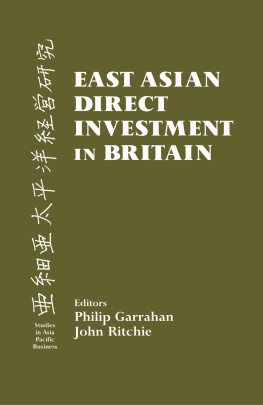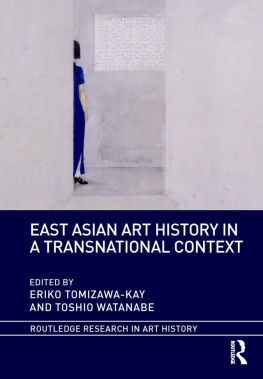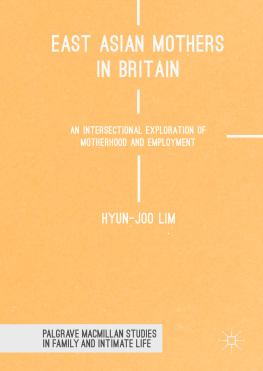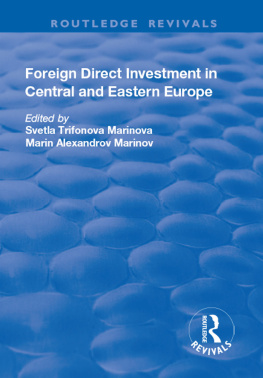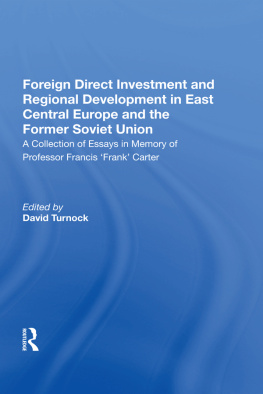East Asian Direct Investment in Britain
Studies in Asia Pacific Business
1369-7153
Editors : Robert Fitzgerald, Chris Rowley and Paul Stewart
Greater China: Political Economy, Inward Investment and Business Culture
Edited by Chris Rowley and Mark Lewis
Beyond Japanese Management: The End of Modern Times?
Edited by Paul Stewart
Management in China: The Experiences of Foreign Businesses
Edited by Roger Strange
Human Resource Management in the Asia Pacific Region: Convergence Questioned
Edited by Chris Rowley
Korean Businesses: Internal and External Industrialization
Edited by Chris Rowley and Johngseok Bae
East Asian Direct Investment in Britain
Edited by Philip Garrahan and John Ritchie
East Asian Direct Investment in Britain
Editors
Philip Garrahan
University of Northumbria at Newcastle
John Ritchie
Durham University Business School
First published in 1999 in Great Britain and in the United States of America by
FRANK CASS PUBLISHERS
Published 2013 by Routledge
2 Park Square, Milton Park, Abingdon, Oxon OX14 4RN
711 Third Avenue, New York, NY 10017 USA
Routledge is an imprint of the Taylor & Francis Group, an informa business
Copyright 1999 Taylor & Francis
British Library Cataloguing in Publication Data
East Asian direct investment in Britain. (Studies in Asia Pacific business; no. 6)
1. Investments, Japanese England, Northern 2. Investments, Foreign, and employment England, Northern
I. Garrahan, Philip II. Ritchie, John
332.6'73'5'0427
ISBN 978 0 7146 4981 8 (cloth)
ISBN 978 0 7146 8044 6 (paper)
ISBN 978 1 3150 3955 8 (eISBN)
ISSN 1369-7153
Library of Congress Cataloging-in-Publication Data:
East Asian direct investment in Britain / edited by Philip Garrahan and John Ritchie.
p. cm. (Studies in Asia Pacific business)
Includes bibliographical references and index.
ISBN 978-0-7146-4981-8. ISBN 978-0-7146-8044-6 (pbk.).
ISBN 978-1-3150-3955-8 (eISBN)
1. Investments, East Asian-Great Britain. I. Garrahan, Philip. II. Ritchie, John, 1949- . III. Series.
HG5432.E17 1999
332.67'35041dc21
9934090
CIP
This group of studies first appeared in a special issue of Asia Pacific Business Review [ISSN 1360-2381], Vol.5, No.2, Winter 1998, published by Frank Cass and Co. Ltd.
All rights reserved. No part of this publication may be reproduced in any form or by any means, electronic, mechanical, photocopying, recording or otherwise, without the prior written permission of the publisher.
Contents
| PHILIP GARRAHAN AND JOHN RITCHIE |
| LOUISE AMOORE |
| MARIE CONTE-HELM |
| IAN STONE |
| JOHN RITCHIE |
| CAROL BURDIS AND FRANK PECK |
| ANDREW PIKE AND JOHNY TOMANEY |
| IAN ROBERTS AND TIM STRANGLEMAN |
| ANDREW CUMBERS |
| JEFFREY HENDERSON, NORIKO HAMA, BERNARD ECCLESTON AND GRAHAME THOMPSON |
PHILIP GARRAHAN AND JOHN RITCHIE
The UK, The European Union, and Foreign Direct Investment
This collection puts East Asian foreign direct investment (FDI) into a United Kingdom context by making more critically apparent the course of its inception and realization in the North of England region. Beginning with an overall account of the position of the UK, alternative regionally related scenarios assess the role of FDI within different localities and sectors. The collection was first conceived amid growing calls for a better understanding of the complexities of FDI, especially as the so-called Asian crisis took hold. The North of England is clearly a leading case in point, since it attracted the highest proportion of all FDI coming into all UK regions between 1994 and 1997. Further, within the wider European Union (EU), the UK has been regarded as highly placed and competitively advantaged where East Asian FDI has been concerned. By thus making its particular course more critically apparent within this leading UK host region, this volume aims to stimulate fresh insights and debates into the still sensitive process by which FDI influences future development prospects.
That process has already been understood very differently even within the last decade alone. At the outset East Asia appeared to be verging upon an economic miracle rarely thought possible before. As progenitor for globalization at large, this economic miracle idea virtually somersaulted into popular consciousness thereafter. Soon formal economic league tables designated likely winners, followers and losers, and concerned states sought to reposition their economic prospects accordingly. For example, the US claimed more growing allegiance with the Pacific than with the Atlantic, and on the edges of the Pacific Rim both Australia and New Zealand did the same. Any EU approach appeared almost distant by comparison, and as the world's largest trading block the EU concerned itself more with its own internal matters.
As Louise Amoore's article shows, the UK acted opportunistically by promoting its more peripheral regions in securing East Asian FDI. This approach soon drew criticism from other EU member states, since the UK was regarded as privileging itself as the 'enterprise centre of Europe'. After the EU launched its 'Towards A New Asia Strategy' document in 1994 some of the formalities changed and three years later the preferred theme for all EU member states became 'Sharing Asia's Dynamism' (UNCTAD, 1997). As the 1990s ended, however, that very dynamism was thrown into serious question. Both the East Asian economic miracle, and the national and regional repositioning strategies that went with it, were increasingly doubted. Ironically, where East Asia had previously appeared the progenitor for globalization, now it seemed the prisoner and victim of these self-same forces: an economic volte-face almost without parallel. So, if an East Asian economic miracle could indeed falter (while further collapses happened in former Soviet states), then the interests of those such as the UK, which had been deliberately positioned to benefit from it, were at risk. Not surprisingly, top think tank-backed calls for rethinking this entire phenomenon were soon forthcoming, requiring much better EU/East Asian related dialogue (Maull, Segal and Wanandi, 1998; Pape, 1998; Sideri, 1995).
In a number of key matters the EU benchmarked the US and Japan, rather than other East Asian countries. For example its 1998 assessment of European competitiveness drew almost exclusively upon these benchmarks alone (EU, 1998). On the other hand these other East Asian countries also regarded the volume and relative shares of their trade and investment with Japan and the US as the more important (Anderson and Francois, 1998). In addition, East Asian fears about non-contingent, exclusionary 'Fortress Europe' protectionism matched EU apprehensions about Japanese and US ascendancy across East Asia generally. Subsequent studies suggest that, especially compared with the US, EU interests in East Asian countries excluding Japan are more complex and expansive than is sometimes supposed. This is despite continuing criticisms about unsatisfactory investment rates (Longhammer, 1998). For example Segal (1998) maintains that, while the overall value of trade remains limited, EU aid to Pacific Asia far exceeds that of the US, while 30 per cent of all IMF crisis relief, notably that directed towards ASEAN states like Thailand and Indonesia, comes from EU member states and is double the US contribution.


